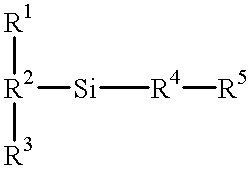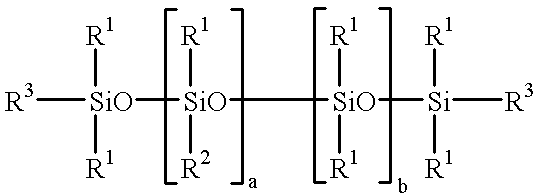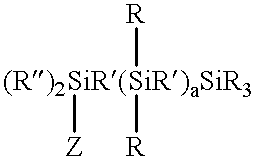Silanes with hydrophilic groups, their synthesis and use as surfactants in aqueous media
a technology of hydrophilic groups and silanes, which is applied in the direction of ampholytes/electroneutral surface active compounds, physical/chemical process catalysts, metal/metal-oxides/metal-hydroxide catalysts, etc., can solve the problems of losing effectiveness and relatively high cost of synthesis of these carbosilanes, and achieves the effect of lowering the surface tension of aqueous solutions
- Summary
- Abstract
- Description
- Claims
- Application Information
AI Technical Summary
Benefits of technology
Problems solved by technology
Method used
Image
Examples
example 2
Reaction of Glycidylpropyltrimethylsilane with Dimethylaminoacetic Acid (Betaine)
Anhydrous dimethylaminoacetic acid (20.8 g, 0.2 moles) and 57.9 mL of isopropanol are added to a 250 mL 3-neck flask, which is equipped with stirrer, reflux condenser and dropping funnel, and heated to 50.degree. C.
After that, 37.8 g of the glycidyloxypropyltrimethyl-silane (0.2 moles) prepared in Example 1, are slowly added dropwise.
At the end of the dropwise addition, stirring is continued for 6 hours under reflux. The product is then freed from solvent and volatile impurities in a rotary evaporator at 80.degree. C. under the vacuum of an oil pump.
A white, powdery solid remains behind. Its 1% solution in distilled water spreads 10 mm on a polypropylene surface and it lowers the surface tension of water to a value of 22.8 mN / m. ##STR16##
example 3
Reaction of Glycidyloxypropyltrimethylsilane with Dimethylisopropylamine / Acetic Acid (Quat)
Glycidylpropyltrimethylsilane (19.67 g, 0.104 moles) is added dropwise to a mixture of 18.13 g of dimethylisopropylamine (0.208 moles), 6.25 g (0.104 moles) of acetic acid and 10.0 g of isopropanol at an internal temperature of 50.degree. C. Stirring is then continued for a further hour at this temperature, a clear solution being obtained after a further hour. After a 5-hour post-reaction at the refluxing temperature, the reaction is concluded. The product is freed from solvent in the rotary evaporator under the vacuum of an oil pump and a temperature of 70.degree. C. A clear, yellow-brown, viscous liquid (% nitrogen: 4.18 theoretical, 3.69 actual; % quaternary nitrogen: 4.18 theoretical, 3.61 actual).
According to the spectroscopy carried out, the product has the following general formula: ##STR17##
A 1% aqueous solution spreads 32 mm on polypropylene and shows a surface tension of 22.6 mN / m.
example 4
Reaction of Glycidyloxypropyltrimethylsilane with Sodium Hydrogen Sulfite (Sulfonate)
Glycidyloxypropyltrimethylsilane (18.9 g, 0.1 moles), 24.12 g of water, 38.3 g of isopropanol and 2.52 g of sodium sulfite (0.02 moles) are added to a 250 mL 3-neck flask, which is equipped with a reflux condenser and a dropping funnel and heated under an atmosphere of nitrogen to the refluxing temperature. A 37% solution (22.5 g) of sodium thiosulfate in water is then added dropwise. At the end of the reaction, the pH of the reaction mixture is adjusted to a value of 7 by the addition of a solution of 10% by weight of acetic acid in distilled water and the mixture is subsequently filtered.
Volatile components are then distilled off in a rotary evaporator, initially at atmospheric pressure and later on under the vacuum of an oil pump, a temperature of 90.degree. C. not being exceeded. At the same time, a white solid material is obtained, the 1% aqueous solution of which spreads 20 mm on a propylene f...
PUM
| Property | Measurement | Unit |
|---|---|---|
| Temperature | aaaaa | aaaaa |
| Length | aaaaa | aaaaa |
| Length | aaaaa | aaaaa |
Abstract
Description
Claims
Application Information
 Login to View More
Login to View More - R&D
- Intellectual Property
- Life Sciences
- Materials
- Tech Scout
- Unparalleled Data Quality
- Higher Quality Content
- 60% Fewer Hallucinations
Browse by: Latest US Patents, China's latest patents, Technical Efficacy Thesaurus, Application Domain, Technology Topic, Popular Technical Reports.
© 2025 PatSnap. All rights reserved.Legal|Privacy policy|Modern Slavery Act Transparency Statement|Sitemap|About US| Contact US: help@patsnap.com



